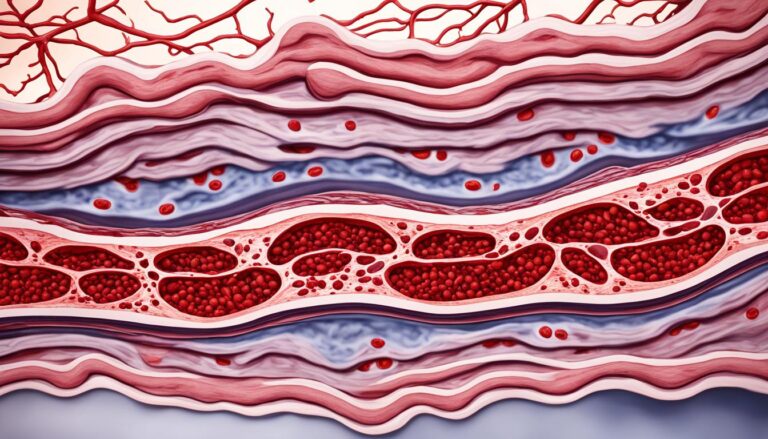Have you ever thought about the different kinds of belly fat and how they affect your health? Learning about female belly fat is key to reaching your wellness goals. But did you know not all belly fat is the same?
Belly fat in women mainly comes in two types: subcutaneous fat and visceral fat. Subcutaneous fat is soft and squishy, found just under the skin, and is less harmful. But visceral fat, which wraps around your internal organs, is more dangerous. Knowing the difference between these fats is important for a healthier, more confident you.
Key Takeaways
- Women typically have greater amounts of subcutaneous fat compared to men.
- Visceral fat, which wraps around internal organs, is more prevalent in men and linked to chronic health issues.
- Factors like age, genetics, and hormones can influence the distribution and accumulation of belly fat in women.
- Maintaining a healthy waist circumference is crucial for reducing the risks associated with excess belly fat.
- Lifestyle choices, such as diet and exercise, can significantly impact the reduction of harmful visceral fat.
Understanding Female Belly Fat Distribution
Belly fat, also known as abdominal or visceral fat, is a big worry for many women. It’s influenced by hormones, age, and genes. Knowing how belly fat works in women is key to losing weight.
Hormonal Influences on Fat Storage
Hormones greatly affect where women store fat. Estrogen, the main female hormone, plays a big role. When estrogen levels drop, like during menopause, more fat goes to the belly.
Age-Related Changes in Fat Distribution
As women get older, their fat storage changes. During menopause, less estrogen means more belly fat. This often leads to the “apple shape” seen in older women.
Genetic Factors in Fat Accumulation
Genes also play a part in where and how much fat is stored. Some genes make it easier to gain belly fat. This can increase the risk of health problems.
It’s important for women to understand how hormones, age, and genes work together. This knowledge helps manage belly fat and improve health and wellness.
| Characteristic | Prevalence in Women | Prevalence in Men |
|---|---|---|
| High Subcutaneous Adipose Tissue (SAT) | 30% | 31% |
| High Visceral Adipose Tissue (VAT) | 44% | 42% |
| Discordance for High SAT and High VAT | 27.8% | 27.8% |
| Both SAT and VAT Below 90th Percentile | 49.3% | 49.3% |
| Both High SAT and High VAT | 22.9% | 22.9% |

Types of Belly Fat Female: Primary Classifications
Understanding belly fat in women is key. There are two main types: subcutaneous fat and visceral fat. Subcutaneous fat is soft and just under the skin, making it easy to pinch. Visceral fat, on the other hand, is deep and wraps around organs, being more active and risky.
Women generally have more subcutaneous fat, making up about 90% of their body fat. But, hormonal shifts, especially during menopause, can increase visceral fat. This is linked to a higher risk of serious health issues.
| Subcutaneous Fat | Visceral Fat |
|---|---|
| Soft, under the skin | Deep, surrounding organs |
| Makes up 90% of total body fat in women | Makes up 10% of total body fat in women |
| More visible and can be pinched | Hidden and more metabolically active |
| Increased risk of chronic diseases | Increased risk of chronic diseases |
Knowing the difference between these belly fats is vital. It helps in finding ways to lose belly fat, whether it’s the visible subcutaneous fat or the hidden visceral fat.

By understanding each belly fat type, women can focus on better health. They can take specific steps to improve their health and well-being.
The Science Behind Visceral Fat in Women
Visceral fat is a hidden layer of fat that wraps around internal organs. It’s a big concern for women’s health. This type of belly fat is active and can affect the body’s overall health.
Metabolic Impact on Internal Organs
Visceral fat is more than just a cosmetic issue. It’s a metabolic powerhouse. Unlike the fat under the skin, visceral fat makes hormones and substances that can harm vital organs.
This fat can mess with liver function, leading to fatty liver disease. It can also cause insulin resistance, which is a step towards type 2 diabetes.
Connection to Chronic Diseases
Too much visceral fat raises the risk of chronic diseases. Women with bigger waists are twice as likely to get heart disease. They also face a threefold risk of dementia and Alzheimer’s disease.
Moreover, they are more likely to develop precancerous colon polyps.
Hormonal Relationships
Hormonal changes, especially the drop in estrogen during menopause, can lead to more visceral fat. This hormonal shift makes it harder to keep a healthy weight and body shape. It shows why women need special strategies to fight visceral fat.

| Statistic | Value |
|---|---|
| Visceral fat typically makes up about 10% of all body fat | 10% |
| Women with larger waists relative to their hip size were twice as likely to develop heart disease | 2x |
| Women with a waist size increase of 2 inches had a 10% higher risk of heart disease | 10% |
| Higher amounts of visceral fat were associated with three times the risk of dementia and Alzheimer’s disease | 3x |
| People with more visceral fat were three times as likely to develop precancerous polyps in the colon | 3x |
Four Body Type Theory and Belly Fat
Understanding belly fat is key to losing weight. The Four Body Type Theory by Dr. Eric Berg sheds light on hormonal imbalances and fat distribution in women.
This theory identifies four body types, each linked to specific hormones and symptoms:
- Adrenal Body Type: Characterized by stress-related, cortisol-driven fat accumulation around the midsection.
- Thyroid Body Type: Linked to high estrogen levels and an underactive thyroid, leading to weight gain across the entire body, including the belly.
- Liver Body Type: Associated with overconsumption of alcohol and fatty foods, resulting in significant weight gain around the abdomen.
- Ovary Body Type: Excess estrogen production can lead to fat deposition in the lower abdomen, hips, and thighs.
Knowing your body type and hormonal imbalances can change your weight loss journey. By focusing on dietary, exercise, and lifestyle changes, you can tackle stubborn belly fat. This leads to a weight loss transformation and better health.
| Body Type | Characteristics | Associated Symptoms |
|---|---|---|
| Adrenal | Stress-related, cortisol-driven fat accumulation around the midsection | Insomnia, low energy, emotional changes |
| Thyroid | High estrogen levels and underactive thyroid, leading to weight gain across the entire body | Brittle nails, thinning hair, exhaustion, headaches |
| Liver | Overconsumption of alcohol and fatty foods, resulting in significant weight gain around the abdomen | Pain in shoulders and knees, irritability, digestive issues, increased hunger |
| Ovary | Excess estrogen production can lead to fat deposition in the lower abdomen, hips, and thighs | Fatigue, heavy periods, low mood, low sex drive, headaches |
Understanding your body type and hormonal imbalances helps you tailor your weight loss and belly fat reduction. This leads to a healthier, more confident you.

Measuring and Identifying Your Belly Fat Type
Figuring out what kind of belly fat you have is key to losing weight. There are a few ways to check your belly fat and find out what type you have.
Waist Circumference Guidelines
Measuring your waist is a simple way to check your belly fat. For women, a waist over 35 inches (89 cm) means too much belly fat. This fat is deep inside and can lead to serious health problems like heart disease and diabetes.
Visual Assessment Methods
You can also look at your belly to see what kind of fat you have. Subcutaneous fat is soft and can be pinched, while visceral fat is harder and can’t be pinched. A belly that hangs down is usually too much visceral fat. A lower pooch might mean hormone imbalances, like too much estrogen.
Professional Evaluation Options
For a precise look at your belly fat, get a professional check-up. This could include body scans or imaging to see how much visceral fat you have. These methods give a detailed view of your fat and help you lose weight better.

Knowing your belly fat type is the first step to a good weight loss plan. Use waist measurements, look at your belly, and get a professional check-up. This way, you’ll understand your body better and work on improving your health and wellness.
Health Risks Associated with Excess Belly Fat
Excess belly fat, especially visceral fat, is a big health worry for many. This fat builds up around the organs inside. Knowing the risks of too much belly fat is key to staying healthy.
Too much belly fat can lead to high blood pressure and unhealthy blood fats. It also raises the risk of sleep apnea. These issues can cause heart disease, a major killer worldwide. Also, it increases the chance of getting type 2 diabetes, a serious condition.
Studies link belly fat to certain cancers, like colorectal cancer in women after menopause. People with a lot of visceral fat are also at higher risk for stroke, fatty liver disease, and early death.
Even if you have a normal body mass index (BMI), too much belly fat is still risky. This shows why it’s important to look at where fat is, not just how much.
Reducing belly fat through diet, exercise, and managing stress can lower these risks. Knowing the dangers of too much belly fat helps people take steps to stay healthy for the long term.
| Health Risks Associated with Excess Belly Fat | Increased Risk |
|---|---|
| High blood pressure | Increased |
| Unhealthy blood lipid levels | Increased |
| Sleep apnea | Increased |
| Heart disease | Increased |
| Type 2 diabetes | Increased |
| Certain cancers (e.g., colorectal cancer in postmenopausal women) | Increased |
| Stroke | Increased |
| Fatty liver disease | Increased |
| Premature death | Increased |
Even with a normal BMI, too much belly fat is risky. A healthy lifestyle, including a good diet and exercise, can help avoid these dangers. This approach promotes overall health and well-being.
Lifestyle Factors Contributing to Belly Fat
Many women struggle with excess belly fat. While genetics and age are factors, lifestyle plays a big role too. Knowing what affects belly fat is key to losing it.
Dietary Influences
What you eat affects your belly fat. Eating too much sugar and trans fats can lead to more belly fat. But, eating whole foods can help prevent it.
Exercise Impact
Exercise is vital for a healthy weight and less belly fat. Doing cardio, strength training, and abdominal exercises helps burn calories and target belly fat.
Stress Management
Stress can make belly fat worse. It raises cortisol, making you hungry for unhealthy foods. Stress-reducing activities like meditation can help keep your body healthy.
| Lifestyle Factor | Impact on Belly Fat |
|---|---|
| Diet High in Sugar and Trans Fats | Increases Belly Fat Accumulation |
| Regular Physical Activity | Reduces Belly Fat |
| Chronic Stress | Contributes to Belly Fat Gain |
By changing these lifestyle habits, you can fight belly fat and improve your health.
Evidence-Based Strategies for Reducing Belly Fat
Many women aim for a flatter, more toned midsection. But, losing belly fat can be tough. Luckily, research has found several proven ways to help.
One top strategy is eating a nutrient-dense, high-fiber diet. Just 10 grams more of soluble fiber daily can cut belly fat by 3.7% in 5 years. Adding lean proteins, whole grains, fruits, and veggies makes you feel full and helps with weight loss.
Exercise is also crucial. High-intensity interval training (HIIT) and strength training are great for losing visceral fat. Try to do 30-60 minutes of exercise daily, mixing cardio and strength for best results.
Managing stress is important too. Stress hormones like cortisol can make you hungry and store abdominal fat. Relax with meditation, yoga, or deep breathing. Also, getting enough sleep helps keep your metabolism healthy and aids in weight loss.
For lasting belly fat loss, adopt a lifestyle change. Slow, steady diet and exercise tweaks, along with stress control, lead to a slimmer, healthier midsection.
“Consistency and patience are key, as sustainable weight loss occurs gradually.”
Conclusion
Knowing about the types and causes of belly fat in women is key. While some things like genetics and aging are out of our hands, we can still make changes. Eating right, exercising, managing stress, and getting help when needed can help us lose belly fat.
By tackling the hormonal, metabolic, and lifestyle factors that affect belly fat, women can work towards a healthier body. This might mean changing what we eat, doing specific workouts, or getting medical advice. A plan that fits each person is the best way to tackle belly fat and boost health.
Getting a slimmer, healthier waist takes time, effort, and a commitment to lasting changes. By understanding what causes belly fat in women, we can take charge of our health. This opens the door to a healthier, more confident life.





